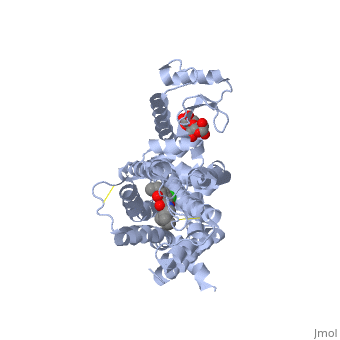User:Erin Elizabeth Sherman/Sandbox 383
From Proteopedia
| Line 1: | Line 1: | ||
| + | <Structure load='3PBL' size='500' frame='true' align='right' caption='Human dopamine D3 receptor in complex with eticlopride' scene='Human dopamine D3 receptor in complex with eticlopride/> | ||
| + | <scene name='User:Erin_Elizabeth_Sherman/Sandbox_383/Human_dopamine_d3_receptor/2'>TextToBeDisplayed</scene> | ||
==Background== | ==Background== | ||
Human dopamine D3 receptor is a protein that encoded by the dopamine receptor gene (DRD3). The DRD3 gene codes for the D3 dopamine receptor that inhibits adenylyl cyclase through inhibitory G-proteins. This receptor is located in the brain, suggesting that the D3 receptor plays a role in cognitive and emotional functions. | Human dopamine D3 receptor is a protein that encoded by the dopamine receptor gene (DRD3). The DRD3 gene codes for the D3 dopamine receptor that inhibits adenylyl cyclase through inhibitory G-proteins. This receptor is located in the brain, suggesting that the D3 receptor plays a role in cognitive and emotional functions. | ||
Revision as of 00:54, 30 November 2011
|
Background
Human dopamine D3 receptor is a protein that encoded by the dopamine receptor gene (DRD3). The DRD3 gene codes for the D3 dopamine receptor that inhibits adenylyl cyclase through inhibitory G-proteins. This receptor is located in the brain, suggesting that the D3 receptor plays a role in cognitive and emotional functions.
Ligands
Ligands that are associated with dopamine D3 receptor are 3-chloro-5-ethyl-N{[(2S)-1-ethylpyrrolidin-2-yl]methyl}-6-hydroxyl-2-methyloxybenzamide (ETQ on PDB) and maltose (MAL on PDB). ETQ binds to dopamine D3 receptor by Asp 110A and Phe346A. MAL binds by Asp 1020A, Glu 1022A, Glu1011A, and Leu1032A.
Disease Involvement
Variations in the DRD3 gene is connected with essential tremor hereditary type 1 (ETM1). ETM1 is the most common movement disorder involving postural tremor of the arms, head, legs, body core, voice, jaw, and other facial muscles. This condition can be provoked by emotions, hunger, fatigue, and temperature extremes. Disorders that are linked to variations in the DRD3 gene include social phobia, Tourette’s syndrome, Parkinson’s disease, schizophrenia, neuroleptic malignant syndrome, attention-deficit hyperactivinty disorder (ADHD), and drug and alcohol dependence.

